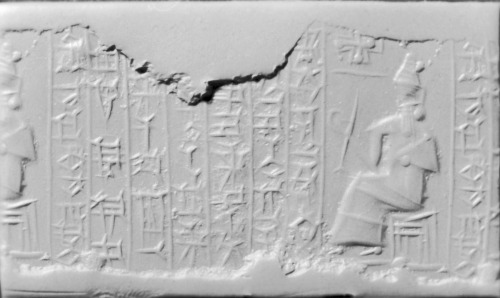Kassite Cylinder Seal, dates to between 1595 and 1155 BC (Middle Babylonian). The impressi
Kassite Cylinder Seal, dates to between 1595 and 1155 BC (Middle Babylonian). The impression of the seal is shown in the second photo. The Kassites were a people from the northwest who installed themselves as the rulers of southern Mesopotamia, unified under the name of Babylonia. They adopted much of its culture, including the cylinder seal. Their seals tend to be tall and thin and often devote much of the surface to inscriptions of prayers, as in this example, which also depicts a seated deity holding divine symbols. The University of Southern California Cylinder Seals and the West Semitic Research Project elaborates on the use of such seals: Cylinder seals were an ancient form of “impression seals,” which are used to make a unique identifying mark on some soft surface–much like some modern letter writers who create a personalized metal stamp seal with their initial(s) to stamp into hot sealing wax dripped on an envelope for creative effect. […] Due to their cylindrical shape, the image on the seal could be rolled infinitely, repeated again and again if desired. […] The seals were used to “sign” clay tablet documents–in the case of the Spurlock seals, commercial receipts–with the unique seal of an individual such as the seller. They can be compared to a notarized signature today. The impression gave visual proof of the genuineness of the object. They could also be used on the clay “envelope” containing the receipt or letter to prove no one had tried to open it since it had left the merchant’s hand. Artifact shown courtesy & currently located at the Walters Art Museum, Baltimore, USA, via the Wiki Commons. -- source link
Tumblr Blog : ancientart.tumblr.com
#mesopotamia#history#archaeology#kassite#cylinder seal#middle babylonian

